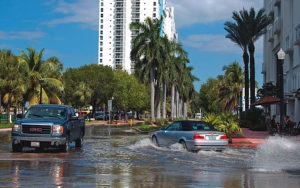Private market growth, FEMA buyouts, and public perception woes

Miami Beach street flooding during 2013 King Tide. Courtesy: Steve Rothaus/Miami Herald
We’ve chronicled the rapid growth of private flood insurance coverage here in Florida and our efforts to export our model laws that encourage private competition to other states. We have a digest of flood news this week, some good, some worrisome – especially on the public’s perception of catastrophe insurance (including whether they carry any). It’s why agent education is so important.
The Insurance Journal carried a story on efforts by private carriers and MGAs to expand the market on their own through innovative measures, some of which started here in Florida. A Munich Re executive, for example, says the number of property owners who’ve added flood as an endorsement to their homeowners policies has doubled in the past year.
Slow but steady growth is everywhere you look. Private flood written premium in the U.S. grew from $376 million in 2016 to $644 million in 2018. That exceeds the surplus lines market of $398 million. Here in Florida, our model laws have doubled the number of private insurance companies writing flood coverage here in the past two years. They’re on track to writing 100,000 private policies by year-end.
The article carried my quote to the National Association of Insurance Commissioners’ Catastrophe Working Group: “This simple idea is designed not only to allow for consumer protections, but to simplify claims handling and perhaps rectify the wind vs flood debate, with one deductible and one adjuster for the property and flood insurance claim.”
Public Perception: A new survey by The Simple Dollar found 55% of Americans believe climate change is increasing storms’ severity and frequency – yet 32% don’t think it will have any impact on their own home.
The personal finance website surveyed 2,700 Americans aged 18 and older to find out if they feel threatened by changing climate conditions and if they’re insured. 57% of people living in the South have home or rental insurance. But overall, 15% of Americans do not insure their homes.
Perhaps most startling: nearly 1 in 3 surveyed under the age of 44 don’t even know if they have insurance! That’s why I keep sounding the alarm and insisting model flood insurance laws include a requirement that agents educate the policyholder on homeowners and flood insurance being two different products and the differences between federal flood (NFIP) and private flood coverage.
FEMA Buyouts: When it comes to the stated policy goal of not rebuilding repetitive flood loss properties, new data shows FEMA’s buyout program has been on a first-come, first-serve basis and likely skews toward more well to do populous coastal communities.
A study in the journal Science Advances, shows FEMA’s Hazard Mitigation Grant Program bought nearly 44,000 buildings from 1989 through 2017 among one-third of all U.S. counties over 49 states. Of those, 3,780 were “complete buyouts” where the building was demolished and the land returned to being open space. Buyout costs weren’t available.
FEMA doesn’t choose which buildings to purchase, but simply responds to state and local governments who submit applications. Although Florida had the highest total property damage of any state at $98.8 billion, it was 24th in the number of homes purchased. Louisiana at $85.4 billion in damage was 19th and Mississippi at $34.2 billion was 22nd in number of buyouts.
LMA Newsletter of 11-4-19

